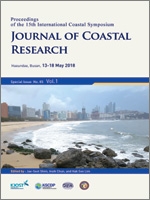Park, W.S.; Won, D.H.; Seo, J.H., and Lee, B.W., 2018. Stability assessment formulas for an interlocking caisson breakwater under oblique wave conditions.. In: Shim, J.-S.; Chun, I., and Lim, H.S. (eds.), Proceedings from the International Coastal Symposium (ICS) 2018 (Busan, Republic of Korea). Journal of Coastal Research, Special Issue No. 85, pp.1236–1240. Coconut Creek (Florida), ISSN 0749-0208.
As a countermeasure for improving the stability of conventional caisson breakwaters, a method has been proposed in which adjacent caissons are interlocked with each other to consecutively resist the abnormal wave forces. It is not possible to reasonably evaluate the stability of breakwaters that have been elongated by interlocking, especially for oblique waves, by using the current design criterion defined for breakwater sections. Therefore, it was studied the stability assessment formula of an interlocking caisson breakwater under oblique wave conditions, in this study. To maintain consistency in checking the stability, it was introduced a reduction factor which is defined as the ratio of the expected maximum force for an oblique wave to that for a perpendicular wave. Using the linear wave theory, the expected maximum force was calculated considering the effect of the phase difference of hydrodynamic pressures along a breakwater. On the other hand, Goda's pressure formula was adopted as a design pressure distribution in the vertical direction to consider nonlinearities and randomness of the design wave, reasonably. Based on these assumptions, safety assessment formulas of the breakwater were developed considering the phase effect between the horizontal and uplift forces. Numerical calculations show that the proposed assessment formula for the interlocking caisson breakwater gives reasonable results, i.e., the estimated stability increases, as the wave attack angle increases. To judge the validity of the results, indirectly, the stabilities were estimated for regular and irregular wave conditions, and the results were compared each other.





